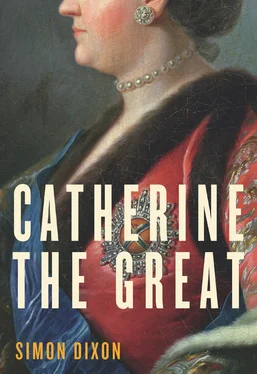Churches were often perishingly cold. On Christmas Day in 1748, when the Court was in Moscow, Catherine and her husband were already preparing to take the carriage to mass when they were told that Elizabeth had excused them because ‘it was twenty-eight or twenty-nine degrees below zero’. It was barely warmer in April, when Catherine returned from the Easter service ‘as blue as a prune’. 73Faced with such icy conditions, courtiers were inclined to stay away, much to the irritation of the empress who accepted only illness as an excuse for their absence (those who failed to attend the blessing of the waters at Epiphany in 1752 were threatened with a ban from Court receptions). 74Less of an ordeal were the summer sanctification services, which appealed to Catherine’s sense of theatre. In her first summer in St Petersburg, she and her mother followed the procession of the cross to a Jordan on the Moika canal. When the ritual was performed at Peterhof—where the upper pond was christened ‘the Jordan’ to symbolise the flow of ‘holy water’ through the palace’s system of ponds and fountains—Elizabeth occupied a gallery lined with velvet to the left of the Jordan, while the attendant notables took their places in a second stand lined with scarlet cloth. 75
On fast days the Court dined on fish and vegetables, though the variety of dishes served scarcely amounted to the sacrifice which many common people made and which threatened to undermine the performance of Russian troops in the field. In and around Moscow alone, there were at least sixty-five imperial orchards and kitchen gardens in the first half of the eighteenth century, supplying the Court with their choicest produce and sending the rest to market. Tons of fruit and berries from the orchards at Kolomenskoye, Izmailovo and Vorobëvo were stewed and sweetened at the end of every summer under the direction of the Court’s deputy confectioner. The largest operation was at Kolomenskoye, where cabbages (Russian, red and Savoy), beans (Russian and Turkish), peas and cucumbers were also grown in prodigious quantities. In 1737 alone, Kolomenskoye supplied 2500 buckets of chopped cabbage, 500 buckets of shredded cabbage and 2000 buckets of cucumber for the imperial table. Mint, used in cooking since the seventeenth century and also for flavouring vodka, became a particular speciality of the Dmitrovo kitchen gardens, which each year supplied between 400 and 500 poods of mint to the Court by the end of Elizabeth’s reign (a pood weighed approximately 36 lb or 16.38 kg).
Gardeners from Kolomenskoye were sent out to advise the winegrowers at Chuguyev; they also travelled to Astrakhan, from where fruit was shipped to Tsaritsyn before beginning the long overland journey to St Petersburg. (In an effort to prevent it from rotting, Elizabeth personally decreed that the posting stations should be no more than thirty versts—around thirty-two kilometres—apart.) Still more Muscovite specialists helped to establish the imperial kitchen gardens in St Petersburg, where several acres of both the Summer Garden and the Italian Garden were given over to orchard and allotments. There were similar establishments at all the suburban palaces, where foreign specialists such as Michelangelo Mass, Justus Riger and Johann Brandt, assisted by Russian apprentices, coaxed radish, cucumbers, lettuce, peas, onions and various sorts of grass and flowers to grow in the orangeries all year round, so that the Court could enjoy them even out of season. 76
And then there were the fish. ‘I have dined with Russians in Lent,’ reported an English governess in St Petersburg in the mid-1730s, ‘and seen them eat heartily of a sole of salmon raw.’ 77The Court was offered even richer pickings. In the normal run of things, the second upper kitchen served up for Catherine and Peter almost exactly the same daily fare as the first upper kitchen prepared for the empress’s table: 3 poods of ham, 1 pood and 20 pounds of mutton, 1 fresh tongue, 1 and a half poods of veal, 4 and a half poods of lamb, 3 pounds of lard, 2 geese, 4 turkeys, 4 duck, 38 Russian hens, 3 suckling pigs, 5 chickens and a selection of grouse and partridge in season. On fast days, these quantities were halved to cater for foreign guests and heterodox courtiers while Orthodox members of the household dined on 6 sterlets (a particular delicacy, generally boiled but sometimes roasted), 14 pike (usually fried), 2 bream, 2 ide-carp, 10 burbots, 16 perch, 10 roach, 3 freshwater salmon, 6 grayling, 2 pike-perch, 1 salmon, 50 ruff fish, 100 crayfish and a variety of salted fish and caviars. 78
* * *
On such a diet, it is no wonder that courtiers were plagued by constipation. But then, as Catherine soon discovered, personal comforts were everywhere subordinated to the relentless requirements of representational display. She grew up surrounded by scaffolding and workmen, ever-present symbols of recurrent alterations to the imperial palaces, usually completed at breakneck speed. If Rastrelli submitted a budget for 200 labourers for a project lasting six months, he was likely to be told to recruit 1200 and complete the job in four weeks, though such a timescale never allowed for the empress’s frequent changes of mind over the details, often announced on a whim over lunch. 79One of the Court architect’s first commissions in St Petersburg, the summer house he built for Empress Anna, was simply chopped in two in 1748 and rebuilt on either side of the palace at Yekaterinhof, where the empress stipulated that the trees should not be destroyed. 80Elsewhere, his pattern was to begin with cosmetic changes before launching into wholesale reconstruction, as at Peterhof. 81‘This was the work of Penelope,’ Catherine remarked of a similar operation at Tsarskoye Selo: ‘they pull down tomorrow what has been built today. This house was destroyed and rebuilt six times before it reached its present state.’ 82The result was a restless progress from palace to palace, in which she and Peter scarcely ever returned to the apartments they had previously occupied.
A thirst for splendour was by no means the only reason why they lived in perpetual discomfort. ‘The Dutch may brag that Amsterdam is built out of the water,’ observed a British visitor in 1741, ‘but I insist that Petersburg is built in spite of all the four elements…the Earth is all a bog, the air is commonly foggy, the Water sometimes fills half the Houses, and the fire burns down half the Town at a time.’ 83Catherine discovered for herself the perils of building on frost-bitten marshland when Aleksey Razumovsky’s three-storey country house at Gostilitsy gave way underneath her in May 1748. Having laid a limestone foundation the previous autumn, the architect had departed for Ukraine leaving strict instructions that the beams he had used to support the vestibule were not to be touched. Thinking them unsightly, the steward of the estate nevertheless had them removed, rendering the whole structure unstable as the foundations began to shift in the spring thaw. Comparing the noise of the collapsing building to a ship of the line shuddering down the launch pad, Catherine was careful to stress in her memoirs that her husband had fled to save his own skin while she selflessly paused to rescue a slumbering member of their household. Whatever the truth of that claim, there was no doubt about the scale of the tragedy. While Catherine’s maid of honour, Princess Anna Gagarina, was dragged bleeding from the wreckage, three labourers were killed on the ground floor and a further sixteen, employed on the neighbouring sleigh-run, were crushed to death in the basement. The distraught Razumovsky threatened to shoot himself while Catherine, who had only just recovered from measles, was bled to relieve her shock. 84
Even architects who built to last were frustrated by the Russian climate. ‘Because spring and summer together last only three months,’ Rastrelli complained, ‘it is very hard to achieve perfection in work on the facades, since barely have they been completed than the cold and damp take hold of them and everything cracks up.’ 85Just as much damage was caused by stoves designed to ward off the elements from the inside. Works of art in themselves, these ceramic monsters played havoc with the interior decoration. Catherine complained loudest about water seeping down the panelling of Moscow’s wooden palaces. 86But condensation was everywhere a menace. No sooner had the celebrated Amber Room, a gift to Peter the Great from Frederick William I of Prussia in 1717, finally been installed in the Winter Palace between 1743 and 1745, than the stone started to come unstuck. As cracks appeared across the entire surface of one of the panels, the room was already under restoration by 1746. 87
Читать дальше












